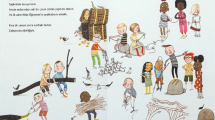Abstract
Children benefit in many ways from actively engaging in high quality children's literature, and picture books provide a natural avenue to motivate and encourage students' writing. Shared book experiences in small or large group settings can lead to meaningful writing discussions and applications. Picture books serve as exemplars of the six qualities of effective writing (ideas, organization, voice, word choice, sentence fluency, and conventions) and provide a scaffold for students to incorporate these writing attributes in their original compositions. When primary students' writing is inspired by high-quality picture books and shared with peers, children benefit academically and socially.









Similar content being viewed by others
References
Culham R. (2005). 6 + 1 traits of writing: The complete guide for the primary grades. Jefferson City, MO: Scholastic
Culham R. (2003). 6 + 1 traits of writing: The complete guide grades 3 and up. Jefferson City, MO: Scholastic.
Culham R. (2004). Using picture books to teach writing with the traits. New York: Scholastic
Cambourne B. (1999). Conditions for literacy learning: Turning learning theory into classroom instruction A minicase study. The Reading Teacher 54(4):414–429
Isernhagen J., & Koziesek J. (2000). Improving students’ self-perceptions as writers. Journal of School Improvement, 1(2), 3–6.
Jacobson J. R. (2005). Six traits writing: Using literature as a model. Book Links. 14(5):44–47
Jalongo M. R. (2004). Young children and picture books. (2nd ed.). Washington, DC: National Association for the Education of Young Children.
Morrow L. M. (2005. Literacy development in the early years: Helping children read and write. (5th ed.). Boston: Allyn and Bacon
James L. A., et al. (2001). How Adam became a writer: Winning writing strategies for low-achieving students. The Council for Exceptional Children 33(3):30–37
Jarmer D., et al. (2000). Six-trait writing model improves scores at Jennie Wilson Elementary. Journal of School Improvement 1(2):29–32
Rickards D., Hawes S. (2005). Learning about literary genres: Reading and writing with young children. Norwood, MA: Christopher-Gordon Publishers
Rushton S. P., et al. (2003). Connecting Brian Cambourne’s conditions of learning theory to brain/mind principles: Implications for early childhood educators. Early Childhood Education Journal 31(1):11–21
Spandel V. (2004). Creating young writers. Boston: Allyn and Bacon
Spandel V. (2005). Creating writers through 6-trait writing assessment and instruction. Boston: Allyn and Bacon.
Tompkins G. (2005). Language arts: Patterns of practice. Columbus, OH: Merrill/Prentice Hall
Children’s Books Cited
Abercrombie B. (1995). Charlie Anderson. New York: Simon and Schuster
Angelou M. (1978). Life doesn’t frighten me. New York: Virago Press Limited.
Base G. (1983). My grandma lived in Gooligulch. New York: Abrams, Inc
Base, G. (1998) The sign of the seehorse. New York: Puffin.
Baylor B. (1974). Everybody needs a rock. New York: Simon & Schuster
Briggs R. (1978). The snowman. New York: Random House.
Cannon J. (1993). Stellaluna. New York: Scholastic.
Cannon J. (1997). Verdi. New York: Scholastic
Clearly B. P. (2001). To root, to toot, to parachute: What is a verb? Minneapolis, MN: Lerner Publishing
Clearly B. P. (2002). Under, over, by the clover: What is a preposition? Minneapolis, MN: Lerner Publishing
Cole, J. & Degen, B. (1992) The magic school bus series. New York: Scholastic
Cooney B. (1982). Miss Rumphius. New York: Scholastic
Cronin D. (2000). Click, clack, moo, cows that type. New York: Scholastic
Fleischman, P. (1988). Joyful Noise Poems for two voices. New York: Harpercollins.
Fleming M. (2004). Grammar tales: A verb for hire. New York: Scholastic
Fox M. (1993). Time for bed. San Diego, CA: Harcourt.
Fox M. (2004). Where is the green sheep? San Diego, CA: Harcourt Children’s ‘Books
Frasier D. (2000). Miss Alaineus. San Diego, CA: Harcourt Children’s Books.
Gile J. (1995). Oh, how I wish I could read! Wisconsin, MO: Worzalla.
Hartman B. (2002). The boy who cried wolf. New York: Scholastic.
Henkes K. (1991). Chrysanthemum. New York: Greenwillow
Johnson S. (1995). Alphabet city. New York: Viking Press
Joose B. M. (1996). I love you the purplest. San Francisco, CA: Chronicle
Mabel-Canton Elementary School Fourth Graders (2002). A band of coyotes. New York: Scholastic
Martin, B., & Archambault, J. (1989). Chicke Chicke boom boom. New York: Simon & Schuster
Pallotta, J. (1991). The icky bug counting book. Watertown, MA: Charlesbridge Publishing
Pulver R. (2003). Punctuation takes a vacation. New York: Holiday House.
Raschka C. (1993). Yo! Yes? New York: Scholastic
Ryan P. (1996). The flag we love. New York: Scholastic
Scieszka J. (1989). The true story of the three little pigs. New York: Viking Press
Turner P. (1996). The war between the vowels and the consonants. Singapore: Tien Wah Press
Wilson K., Rankin J. (2003). A frog in the bog. New York, Scholastic
Wilson S. (2004). A nap in the lap. New York: Scholastic
Winthrop E. (2001). Dumpy LaRue. New York: Henry Holt and Company
Wood A. (1984). The napping house. San Diego, CA: Harcourt
Wood, A., & Wood, D. (1985). King Bidgood’s in the bathtub. Orkudo, Fl: Harcourt
Author information
Authors and Affiliations
Corresponding author
Rights and permissions
About this article
Cite this article
Paquette, K.R. Encouraging Primary Students’ Writing through Children’s Literature. Early Childhood Educ J 35, 155–165 (2007). https://doi.org/10.1007/s10643-007-0183-6
Received:
Accepted:
Published:
Issue Date:
DOI: https://doi.org/10.1007/s10643-007-0183-6




